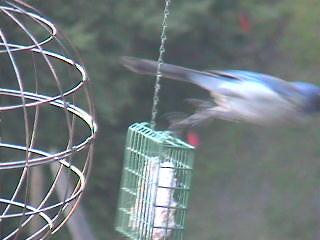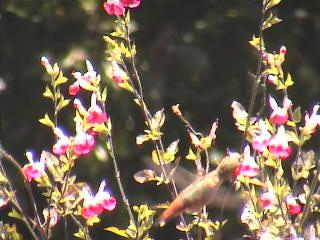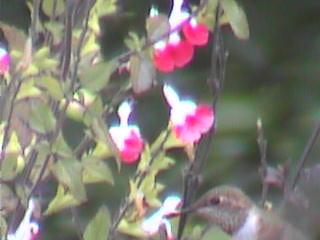Here are my favorite shots from today.
lal got this cute action shot of the Western Scrub-Jay. Exit, stage right:
spurdin got this wonderful shot of the Allen’s Hummingbird:
And noho_bird_club got this incredible close-up, also of the Allen’s Hummingbird:
User tedr commented on that last one, “Note the bright white throat, lack of white above the eye (but a faint eye-stripe posterior to the eye) and the ‘hint’ of rufous on the sides.” All of which is true; those field marks are clearly visible. (And thanks to tedr for educating me about that; I never noticed the first two of those.) Checking the field guide, I also notice that you can pretty much make out the “orange ‘eyebrow'” that Sibley talks about.
Yup, no two ways about it: It’s a Selasphorus female. We’re calling her an Allen’s, and I’m fairly comfortable doing so, but of course, from these shots there’s really no way to say she couldn’t be a female Rufous Hummingbird. We’re saying Allen’s based mainly on the idea that the Rufous hummers have already migrated through to their more-northerly breeding grounds, in Oregon and points north. I’ve read that experts can distinguish the two Selasphorus species by making a careful examination of the tail feathers when holding a bird in the hand during banding operations, but I’m not expecting we’ll get that kind of detail via the birdcam.
Any way you slice it, though, she’s a beautiful bird, and these are great shots.



Even with the tail measurements, it is difficult to tell the females and hatch-year males
apart. Pyle’s Identificaion Guide to North American Birds, (the bander’s manual) , says
that you can tell them apart with caution. The Rufous has a notch in The second tail feather
out from center, but that’s not always easy to tell. It also has broader tail feathers.
Sometimes you just have to say it’s a Selasphorus and leave it at that.
Thanks for the lesson Vireo, I put up two hummingbird feeders yesterday and today they are feeding out of them! I love watching them feed and I always know when they are near because they have that beeping sound.
Keep an eye on your feeders to see if different kinds of hummers come to them. Depending on where you live, you may see different species come through during migration. Also, I
have Chestnut-backed chicadees come to the hummer feedesr as well as Hooded and Bullock’s Orioles! It’s quite a gathering sometimes and fun to watch.